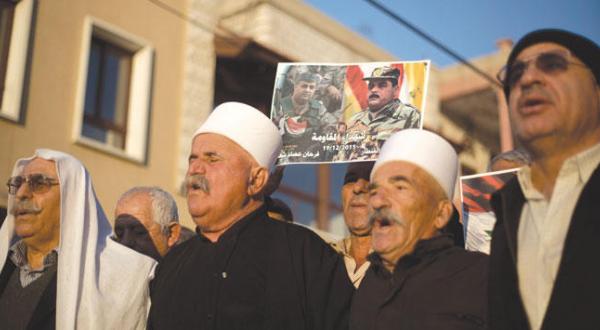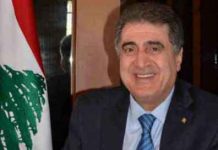Who killed Hezbollah’s Samir Qantar? Ask Syria
Raed Omari/Al Arabiya/December 21/15
Up until the time of writing, there has been no absolute statement from the Syrian government confirming that Lebanese militant leader Samir Qantar was killed in an Israeli aerial raid, as announced by Hezbollah. The Syrian government´s public explanation of the incident was expressed in remarks carried by the state-owned SANA news agency that lacked a clear-cut pointing-finger to Israel as being behind Qantar´s death. But let it be very clear from the very beginning that what is written here is not a conspiracy theory piece accusing the Syrian regime of killing Qantar, although there has always a big question mark hanging over the deaths of many militant leaders and allies in Syria.
I was taken aback by the Syrian official statement on the killing of Qantar, a Druze, who was released by Israel in 2008 as part of a prisoner swap with the Lebanese Shiite group Hezbollah. Perhaps by pointing the finger at Israel, Hezbollah said what the Syrians were unable to say. In January this year, the two longtime allies´ statements on Israel´s killing of six Hezbollah members, including commander and son of the group´s leader Imad Mughniyah in Quneitra were identical, accusing the same enemy and pledging coordinated revenge. But this time it was different.
Remarkably enough, the Syrian account of the incident resembled to a greater degree that of Israel – no confirmation and no refuting
Hezbollah´s al-Manar TV aired an official statement by the Shiite militia affirming that Qantar was killed in an Israeli airstrike on a residential district of Damascus. Meanwhile, according to the Syria, as SANA announced, the Lebanese militant leader was killed in a ´´terrorist rocket attack.” From a purely discourse analysis point of view, the Syrian official statements appeared to want to contain the incident. SANA quoted Syria´s Information Minister Omran al-Zoubi as describing Qantar´s killing as a ´´terrorist operation plotted beforehand´´ without accusing Israel or any party. In a statement, also carried by SANA, the Syrian People´s Assembly accused a combination of “Takfiri Zionist” forces ´´led by several countries topped by Israel´´ of killing Qantar – again, not directly accusing Israel.
Daring, but still not clear
Syria´s Prime Minister Wael al-Halaqi’s statement was somehow a bit more daring, carrying some accusations against Israel but against other parties as well reading, as cited by SANA: ´´This attack will not prevent the Axis of Resistance from continuing its struggle against the Israeli enemy and confronting the terrorist war waged on Syria and the Arab nation.´´The three Syrian official statements issued so far were all loose, coy and full of diplomatic euphemisms, so to speak.
None of the statements have made it clear that Qantar was killed in an Israeli airstrike on a Damascus suburb, as announced by Hezbollah. Syria’s conventional sentence “Syria reserves the right to retaliate by all means at its disposal” was entirely absent in all the three official statements on Qantar’s death. Remarkably enough, the Syrian account of the incident resembled to a greater degree that of Israel – no confirmation and no refuting.
But the Syrian statements on Qantar´s killing were worded with a heavy Russian military presence in the background and they were inseparable from new political developments on Syria and the new international coalitions in the making. It can´t be that the Israelis launched an airstrike on Syria now without coordination with their Russian allies who now control Syria´s airspace. And if the Syrians confirmed that Israeli jets killed Qantar, then they would appear as either having prior knowledge of the plan or have no sovereignty over their country. Who actually killed the 54-year-old Qantar? In my opinion, Israel is a likely perpetrator but the question is how its jets flew over Syria now without being spotted by the Russian satellites and space power. The Russian silence on the incident is also worth-noting. In fact, the killing of Qantar is proof that Syria is no longer a safe place even for the Syrian regime’s allies and loyalists. All is relative amid the overlapping interests from the many parties embroiled in the Syrian war.
The U.N. plan for Syria has two major flaws
Brooklyn Middleton/Al Arabiya/December 21/15
The U.N. Security Council unanimously passed resolution 2254, outlining what it refers to as a “roadmap” for peace in Syria. Despite the fact that the most important parties on the Security Council have publicly hailed the 16-point resolution as promising, there are two major flaws that jeopardize the effectiveness of the potential plan. The agreement fails to address the future of Bashar al-Assad’s disgraced regime in any meaningful manner. Stipulation 4 of the resolution notes that there needs to be a political process overseen by the U.N. within six months, which plans for a new constitution as well as elections within the following 18 months. Nowhere in this stipulation indicates the Assad regime must first step down before free and democratic elections can take place. While there was no likelihood Russia would vote for an alternative resolution that explicitly addressed Assad’s ousting, ignoring the issue entirely paves the way for Assad to run.Failing to unequivocally plan for Assad’s departure will only prolong the conflict while the humanitarian situation worsens
The Assad regime was already reelected in the polls, widely believed to be sham elections, which took place in June 2014. The election only took place in government-controlled areas; Assad campaign posters were hung, while pockets of his own population were being intentionally starved to death. With every barrel bomb, act of torture and chemical weapon attack, Assad destroyed any legitimacy he had as a ruler. His regime has also contributed to the ISIS’s wealth by reportedly buying their oil and continuously failing to aerially bombard the militant group’s positions. His regime should be as represented in future elections as much as ISIS is.
Determining terrorist groups
The second major problematic aspect of the agreement is stipulation 9 which indicates that the U.N. “welcomes the effort that was conducted by the government of Jordan to help develop a common understanding within the ISSG of individuals and groups for possible determination as terrorists and will consider expeditiously the recommendation of the ISSG for the purpose of determining terrorist groups.”That there has been no consensus yet reached regarding which groups will be considered terrorist organizations is concerning.
Days prior to the passing of the resolution, Assad himself noted: “For us, in Syria, everyone who holds a machinegun is a terrorist.” Moreover, he continued, his regime would not sit down to political talks with “any armed groups.” It is an obvious point but one worth reiterating, if the Assad regime continues to classify all armed groups as terrorists – as he did even in the most embryonic stages of the conflict – Amman’s efforts will prove futile. The Syrian conflict desperately needs to come to a decisive end and U.N. efforts to facilitate this must continue without pause. However, failing to unequivocally plan for Assad’s departure will only prolong the conflict while the humanitarian situation worsens. Worryingly, a roadmap that fails to discuss Assad’s grip on power and which armed groups should be targeted will likely lead to nowhere.



















